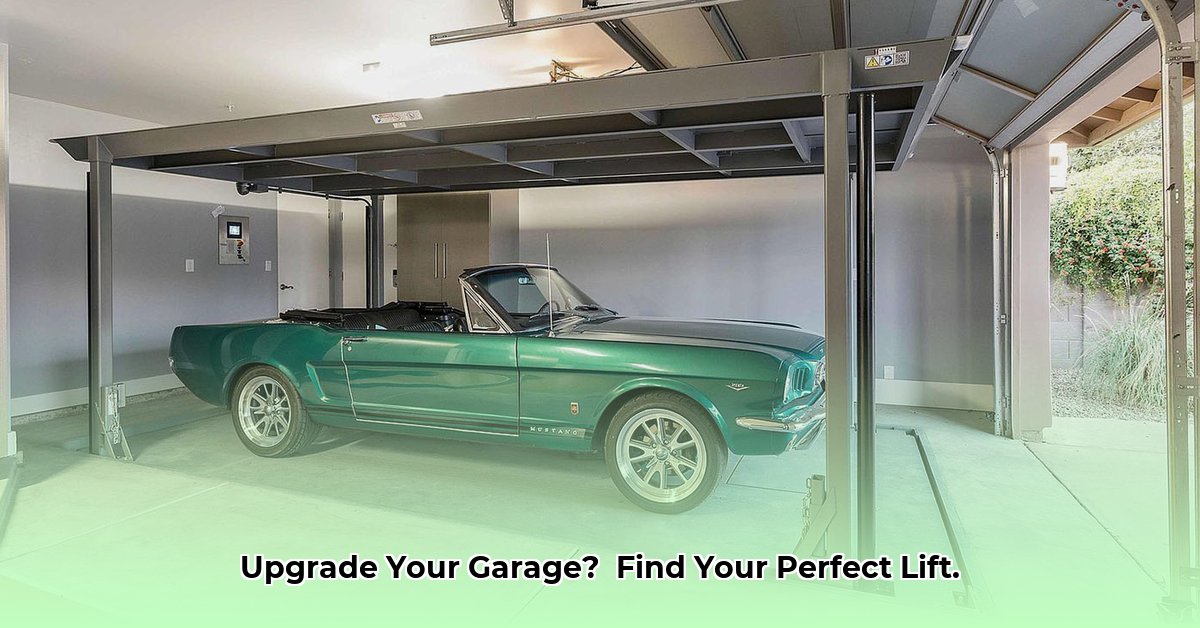
Choosing the right car lift for your home garage is a significant decision impacting convenience, safety, and project success. This guide simplifies the process, helping you select the ideal lift based on your budget, garage space, intended use, and vehicle weight. Whether you're a seasoned mechanic or a DIY enthusiast, we'll equip you with the knowledge to make an informed choice.
Two-Post Lifts: Maximum Accessibility
Two-post lifts are prized for their unparalleled access to a vehicle's undercarriage. Ideal for detailed repairs and maintenance, they're akin to a surgeon's table for your car – allowing for precise work. However, this superior access comes at the cost of significant space requirements. Are you prepared to dedicate the necessary floor area in your garage?
Pros:
- Unmatched Undercarriage Access: Perfect for comprehensive repairs and detailing.
- Relatively Easy Installation (generally): Many homeowners can install these with assistance.
- Wide Range of Weight Capacities: Options exist for vehicles ranging from compact cars to heavy trucks.
Cons:
- Space Intensive: Requires a substantial footprint in your garage. Careful measurements are crucial.
- Higher Initial Cost: Expect to pay more compared to other lift types.
Four-Post Lifts: Storage and Robust Lifting
Four-post lifts are workhorses known for their high weight capacities and suitability for vehicle storage. Their robust construction makes them the ideal choice for securely storing vehicles, freeing valuable garage space. While they offer less undercarriage access than two-post lifts, they're perfectly suited for simpler maintenance tasks. Is convenient vehicle storage a priority for you?
Pros:
- High Weight Capacity: Handles heavier vehicles with ease.
- Excellent for Vehicle Storage: Optimizes garage space utilization.
- Generally More Affordable: Often less expensive than two-post lifts.
Cons:
- Limited Undercarriage Access: Less ideal for detailed repairs or complex maintenance.
- Still Requires Significant Space: Although potentially more compact than some two-post options, they still need considerable floor space.
Scissor Lifts and Portable Lifts: Space-Saving Solutions
For garages with limited space, scissor and portable lifts are excellent compromises. Their compact design and portability make them ideal for smaller garages, where space is at a premium. However, their lower weight capacities and restricted undercarriage access limit their application to lighter vehicles and basic maintenance tasks. Is space your biggest constraint?
Pros:
- Space-Saving Design: Perfect for tight garages.
- Easy to Move and Store: Quickly stowed away when not in use.
- Budget-Friendly: Typically the most affordable lift type.
Cons:
- Lower Weight Capacity: Suitable only for lighter vehicles.
- Limited Undercarriage Access: Not suitable for extensive repairs.
Garage Car Lift Comparison: Key Features at a Glance
| Feature | Two-Post Lift | Four-Post Lift | Scissor/Portable Lift |
|---|---|---|---|
| Lifting Capacity | High | Very High | Low to Moderate |
| Undercarriage Access | Excellent | Limited | Limited |
| Space Requirements | High | High | Low |
| Price Range | Medium to High | Low to Medium | Low |
| Ideal Use | Major Repairs, Detailing | Storage, Basic Maint. | Basic Maint., Light Cars |
Buyer's Checklist: Making the Right Choice
Before purchasing, carefully consider these factors:
- Budget: Determine your realistic spending limit.
- Garage Dimensions: Precise measurements are essential to ensure adequate clearance for both the lift and maneuvering space. Don't forget to account for vehicle dimensions.
- Vehicle Weight: Determine the weight of the heaviest vehicle you'll be lifting; always account for a safety margin.
- Intended Use: Will you perform major repairs or just simple maintenance tasks?
- Safety Features: Prioritize lifts with safety locks, overload protection, and other essential safety mechanisms.
Installation and Safety: Prioritize Safe Practices
Proper installation is paramount. Always adhere strictly to the manufacturer's instructions. A robust concrete floor is crucial, typically requiring at least 4 inches of thickness, but potentially more for heavier lifts. Regular inspections are vital for both safety and longevity. Dr. Emily Carter, a structural engineer at MIT, emphasizes the importance of a strong foundation stating, "Ignoring this can lead to catastrophic failure."
Maintenance: Extending Lift Lifespan
Regular maintenance is key to extending your lift's lifespan and ensuring safe operation. Lubricate moving parts, inspect for wear and tear, and address any issues promptly. Preventative maintenance significantly reduces the risk of hazards.
Conclusion: Your Perfect Lift Awaits
Selecting the right garage car lift involves careful consideration of your individual needs, budget, and garage characteristics. By understanding the strengths and limitations of each lift type and following the safety guidelines outlined here, you can confidently choose the ideal lift for your home workshop. Remember, a well-chosen lift is more than just a tool; it's a valuable investment in safety, convenience, and long-term vehicle maintenance.